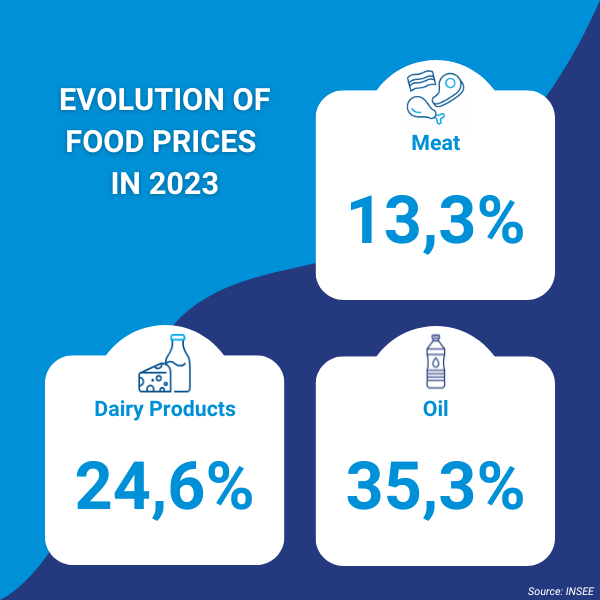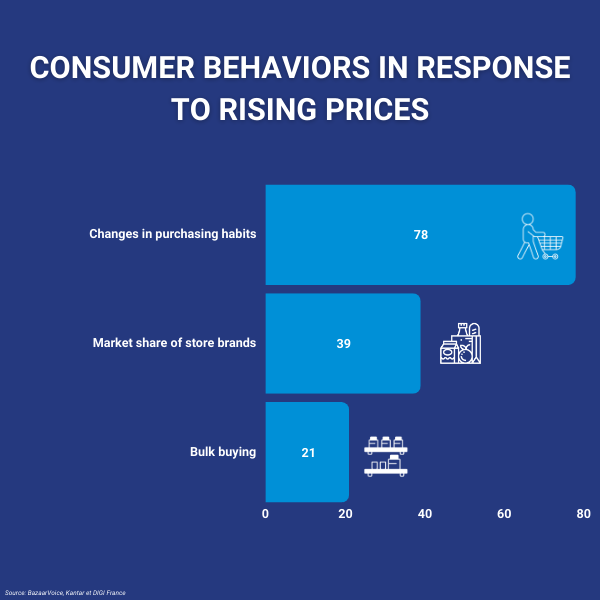For several months, the food industry has been experiencing high inflation, impacting numerous consumer products. This price increase, linked to economic, geopolitical, and environmental factors, is changing the habits of French people. In 2023, food inflation in France reached 11.9%, significantly affecting consumers (Association Famille Rurales). Consumers must adapt, while industrial players redefine their strategies to cope with this growing price pressure.
The rise in prices in the food industry results from multiple factors, going beyond simple cost increases. Economic pressures, geopolitical tensions, and environmental challenges contribute to making the production environment increasingly costly. Among the main factors are:
The costs of raw materials (cereals, oils, meat, milk) have increased significantly, largely due to global geopolitical crises like the war in Ukraine, which have disrupted supply chains. In 2023, meat increased by 13.3%, dairy products by 24.6%, and oils by 35.3% (INSEE). Moreover, the rise in fertilizer and energy prices has also weighed on production, with a 15.2% increase in food industry production prices (Agreste).

Logistics costs have increased substantially due to the COVID-19 pandemic and phenomena such as labor shortages and rising maritime transport costs. Container transportation costs have quadrupled since 2024, fueling inflation in the food industry (IG).
Climate conditions, such as droughts and floods, affect agricultural production, reducing the supply of certain commodities and increasing prices. In 2022, drought decreased cereal production in France by 10% (European Commission). Price increases are also due to rising agricultural production costs and the investments necessary to ensure sustainable production in the face of climate change.
The increase in food industry prices has profoundly changed consumer behaviors, who must adapt their priorities during periods of inflation. These adjustments translate into new purchasing trends:
Faced with inflation, many consumers adjust their habits, prioritizing promotional periods or sales to save money. 78% of French people have modified their purchases due to the economic situation (BazaarVoice). Many consummers buy in larger quantities to limit unit expenses, and the growing use of online platforms allows for better purchase planning and finding the best offers.
With rising prices, consumers are seeking cheaper alternatives. In 2023, distributor brands represented 39.1% of the food industry market (Kantar), considered more economical than major brands. Promotions are closely examined, and bulk purchasing becomes more common to reduce unit costs.
Consumers are adopting more sustainable practices, such as reducing food waste and buying in bulk. In 2023, 21% of French people were buying bulk products every week (DIGI France). Moreover, the consumption of vegetarian and vegan substitutes, often less expensive than traditional meat, is booming.

Faced with growing cost pressures, food industry companies are now confronted with a major strategic challenge: how to reduce production costs while maintaining competitiveness and meeting consumer expectations. To address this issue, it becomes imperative for industrial players to optimize their total cost of ownership (TCO) of equipment and processes.
In this context, solutions like those offered by Acemia play a key role. Specialized in conveying and handling, Acemia helps companies reduce their operational expenses, both short and long-term. For example, by opting for more efficient conveying equipment, companies can not only minimize installation costs but also significantly reduce maintenance and operating costs.
Handling solutions, meanwhile, help rationalize production flows, increase productivity, and limit human errors, which are additional sources of costs. This type of innovation, which relies on process and automation, becomes an imperative to remain competitive while controlling costs in an increasingly uncertain economic environment. By integrating these solutions, companies can transform what is usually perceived as a cost center into a genuine strategic performance lever.
The rise in prices in the food industry forces companies to rethink their strategies to remain competitive in the face of cost pressures and consumer expectations. They must innovate to offer affordable products while optimizing their processes and effectively managing raw material and logistics cost fluctuations. This transformation period could lead to lasting changes in their business models and their ability to respond to complex economic challenges ahead.
